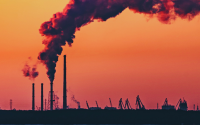Joanna WaltersJune 9, 2002
Ian McNaught-Davis has spent a long time in the mountains. Stocky and affable, the president of mountaineering's international association, the UIAA, is not easily fazed. But when he hiked into the glaciers surrounding the world's highest mountains on a UIAA mission funded by the United Nations Environment Program, he was profoundly shocked.
For generations of explorers, environmentalists and local people, these cold Himalayan valleys, with glaciers that stretch for miles, seemed to symbolize a kind of cold, brutal permanence.
After hiking through zero visibility and atrocious weather for five days, McNaught-Davis emerged into a sherpa village surrounded by breathtaking scenery. There he was confronted with a shocking truth: the glaciers on Everest were melting alarmingly quickly.
McNaught-Davis listened as kinsmen of Nepalese sherpa Tenzing Norgay, who conquered Everest with Sir Edmund Hillary in 1953, reported a rapid retreat of the Khumbu glacier from which the two pioneers set out.
Sherpas and Buddhist lamas told him the glacier no longer reached to where Hillary's base camp tents were pitched: it had melted three miles up the valley.
To check their accounts, McNaught-Davis climbed up to a glacial meltpool at 5,000 meters that 20 years ago was marked on maps as a series of small ponds.
He found that the ponds had merged into a vast lake more than a mile long. 'It was huge. I was completely amazed,' he said. 'Further up the glacier you can see more ponds forming.'
And it is happening so quickly that map makers cannot keep up. Locally, the prospect of these glacial lakes bursting their banks and obliterating whole villages is frightening. Globally, McNaught-Davis believes what mountaineers are seeing first is a bellwether for the climate change affecting us all.
'It is a harbinger, a clue that something terrible is happening. Some scientists say "It must be other factors", but when you talk to people who have lived and climbed in these mountains for 60 years they say it is getting warmer, and the glaciers are shrinking at a sprint.'
Closer to home in the Alps, mountaineers report that rock pillars held on to their crags by ice for thousands of years are simply crumbling away as the ice melts. The climbing and skiing resort of Chamonix is under threat in the long-term, as the peaks around Mont Blanc begin to lose their ice and become more prone to avalanches.
McNaught-Davis said a recent visit to the Eiger in Switzerland was a shock too. 'The north face used to have three massive ice fields. The last time I was there, there was one left, and it was almost gone.'
Glaciers on the African peaks of Kilimanjaro and Mount Kenya are receding rapidly, and the same is happening in the South American Andes.
It is not only the mountain glaciers that are melting. American NASA scientists say the rate at which the huge Greenland ice sheet is melting has increased by a fifth in the last two decades.
This is because more meltwater is trickling down from the surface of the sheet to the bedrock 1,200 meters below. The water 'lubricates' the path of the whole sheet, causing it to slip faster towards the sea. Team member Jay Zwally said such a process had never before been detected in large ice sheets.
NASA believes global warming could be to blame - and it is the first time the scientists have suggested such a link.
This pattern is repeated in all the world's coldest places. Antarctica has been the scene of huge collapses of ice shelves. In the Arctic, seasonal melting around the North Pole has led to a suggestion that soon shipping will be able to navigate the North West Passage from the Atlantic to the Pacific.
All this comes as the world's environment Ministers failed at a meeting in Bali last week to agree tough action to halt global warming and wipe out poverty. They now approach the Earth Summit in Johannesburg in August in disarray and facing accusations of betrayal from environmental groups.
Kate Hampton, international climate campaigner for Friends of the Earth, sees a direct link between disagreement among Western nations about how to tackle pollution and the reports of vanishing ice sheets. 'Glaciers are the water towers of the world - vital for storage. If they are melting fast this has grave implications for the people who live locally but is also a sign of global warming.
'Water supplies everywhere are under threat from climate change,' she said.
Water is a vital bargaining chip in any Middle East peace talks. While politics and religion grab the headlines, shrinking water resources in this dry region are always a major factor when negotiators draw lines on maps.
Hampton warned that without serious strategies to reverse global warming, the next few decades would see tens of millions of 'climate refugees' fleeing regions in Africa and Asia, where extreme drought and floods become the norm.
'What will happen when millions of Bangladeshis from the flood plains are literally washed out, and end up spilling into poor parts of India?' she said.
In the US scientists are warning that the 'sunshine state' of California could become the 'desert state'.
The Intergovernmental Conference on Climate Change has already established that the average temperature on Earth rose by 0.6 C in the twentieth century. They predict it will be between 1.4 C and 5.8 C warmer by 2100 than it was in 1990. The sea could rise by between nine and 88cms.
The higher end of these forecasts spells an environmental apocalypse. Today it means a few disappointed ice climbers, but by the end of the century it could mean death for tens of millions.
In Britain the winters are already becoming warmer, with violent storms and flash floods more frequent. Hampton said the reports of disappearing Himalayan glaciers confirmed what many scientists and environmentalists had been saying for a decade.
'This is a serious issue in areas where the people who live there are the least responsible for causing the problem - industrialized nations are not getting to grips with this in the face of the most overwhelming evidence,' she said.
The Kyoto protocol was meant to make the climate targets reached at the Rio Earth Summit 10 years ago more enforceable.
But while the European Union is preparing to sign up to the protocol this year the US first watered it down, then walked away from it - holding the world's climate hostage, said Hampton.
Campaigners are worried that what should in effect be an emergency summit to save the planet in Johannesburg will be at best a farce and at worst a confirmation of the power of corporate America over the environment - with President George W. Bush presiding as polluter-in-chief.
Ian McNaught-Davis believes every car-driving Westerner munching fruit flown in from halfway around the globe must take a share of responsibility for pumping climate-warming carbon dioxide into the atmosphere.
'It's about time we slowed this whole thing down and stopped it. If the US would get off their arses, maybe someone would sit up and take notice,' he added.






